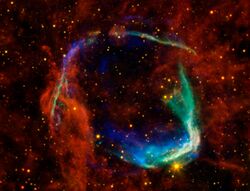Astronomy:SN 185
 Infrared images from NASA's Spitzer Space Telescope and WISE are combined with X-ray data from the Chandra X-ray Observatory and ESA's XMM-Newton Observatory in this image of RCW 86. | |
| Spectral class | Type Ia? |
|---|---|
| Date | 7 December 185 |
| Constellation | Circinus and Centaurus |
| Right ascension | 14h 43m |
| Declination | −62° 30′ |
| Epoch | J2000 |
| Galactic coordinates | G315.4−2.3 |
| Distance | 2,800 pc (9,100 ly)[1] |
| Remnant | Shell |
| Host | Milky Way |
| Notable features | Ancient records of SN 185 may be the earliest written description of a supernova. |
| Peak apparent magnitude | "as much as -8"[2] |
| Preceded by | None known |
| Followed by | SN 386 |
SN 185 was a transient astronomical event observed in the year AD 185, likely a supernova. The transient occurred in the direction of Alpha Centauri, between the constellations Circinus and Centaurus, centered at RA 14h 43m Dec −62° 30′, in Circinus. This "guest star" was observed by Chinese astronomers in the Book of Later Han (后汉书),[3] and might have been recorded in Roman literature.[2] It remained visible in the night sky for eight months. This is believed to be the first supernova for which records exist.
History
The Book of Later Han gives the following description:
In the 2nd year of the epoch Zhongping [中平], the 10th month, on the day Guihai [癸亥] [December 7, Year 185], a 'guest star' appeared in the middle of the Southern Gate [南門] [an asterism consisting of ε Centauri and α Centauri], The size was half a bamboo mat. It displayed various colors, both pleasing and otherwise.[4] It gradually lessened. In the 6th month of the succeeding year it disappeared.[5]
The gaseous shell RCW 86 is probably the supernova remnant of this event and has a relatively large angular size of roughly 45 arc minutes[1] (larger than the apparent size of the full moon, which varies from 29 to 34 arc minutes). The distance to RCW 86 is estimated to be 2,800 parsecs (9,100 light-years).[1] Recent X-ray studies show a good match for the expected age.[6]
Infrared observations from NASA's Spitzer Space Telescope and Wide-field Infrared Survey Explorer (WISE) reveal how the supernova occurred and how its shattered remains ultimately spread out to great distances. The findings show that the stellar explosion took place in a hollowed-out cavity, allowing material expelled by the star to travel much faster and farther than it would have otherwise.[7]
Differing modern interpretations of the Chinese records of the guest star have led to quite different suggestions for the astronomical mechanism behind the event, from a core-collapse supernova[7] to a distant, slow-moving comet[8] – with correspondingly wide-ranging estimates of its apparent visual magnitude (−8 to +4). The recent Chandra results suggest that it was most likely a Type Ia supernova (a type with consistent absolute magnitude),[7][9] and therefore similar to Tycho's Supernova (SN 1572), which had apparent magnitude −4 at a similar distance.
Gallery
- The SMARTS 0.9-meter Telescope has captured an echo of the past in this image. RCW 86 is a literal shell of its former self, the gaseous remnant of a supernova.[10]
See also
- List of supernovae
- History of supernova observation
- List of supernova remnants
- List of supernova candidates
References
- ↑ Jump up to: 1.0 1.1 1.2 Völk HJ; Berezhko EG; Ksenofontov LT (2005). "Magnetic field amplification in Tycho and other shell-type supernova remnants". Astron. Astrophys. 433 (1): 229–40. doi:10.1051/0004-6361:20042015. Bibcode: 2005A&A...433..229V. http://www.aanda.org/index.php?option=article&url=/articles/aa/full/2005/13/aa2015/aa2015.right.html&access=standard.
- ↑ Jump up to: 2.0 2.1 Stothers, Richard (1977). "Is the Supernova of A.D. 185 Recorded in Ancient Roman Literature?". Isis 68 (3): 443–447. doi:10.1086/351822.
- ↑ Zhao FY; Strom RG; Jiang SY (2006). "The Guest Star of AD185 Must Have Been a Supernova". Chinese Journal of Astronomy and Astrophysics 6 (5): 635–40. doi:10.1088/1009-9271/6/5/17. Bibcode: 2006ChJAA...6..635Z.
- ↑ Ye, Fan. Book of the Later Han. http://chinesenotes.com/houhanshu/houhanshu113.html.
- ↑ 《後漢書·卷十二·天文下》:"中平二年十月癸亥,客星出南門中,大如半筵,五色喜怒稍小,至後年六月消。占曰:‘為兵。’至六年,司隸校尉袁紹 誅滅中官,大將軍 部曲將 吳匡 攻殺 車騎將軍 何苗,死者數千人。"
- ↑ "New evidence links stellar remains to oldest recorded supernova". ESA News. 2006-09-18. http://www.esa.int/esaCP/SEMGE58LURE_index_0.html.
- ↑ Jump up to: 7.0 7.1 7.2 "NASA Telescopes Help Solve Ancient Supernova Mystery". NASA. 2011-10-24. http://www.nasa.gov/mission_pages/spitzer/news/spitzer20111024.html.
- ↑ Y.-N. Chin; Y.-L. Huang (29 September 1994). "Identification of the Guest Star of AD 185 as a comet rather than a supernova" (PS). Nature 371 (6496): 398–399. doi:10.1038/371398a0. Bibcode: 1994Natur.371..398C. http://mail.tku.edu.tw/einmann/papers/SN185.ps.
- ↑ Williams, Brian J. (October 2011). "RCW 86: A Type Ia Supernova in a Wind-blown Bubble". The Astrophysical Journal 741 (2): 96. doi:10.1088/0004-637X/741/2/96. Bibcode: 2011ApJ...741...96W.
- ↑ "Dynastic Vibes". https://noirlab.edu/public/images/iotw2236a/.
External links
- NASA Astronomy Picture of the Day: RCW 86: Historical Supernova Remnant (28 September 2006)
- NASA Astronomy Picture of the Day: RCW 86: Historical Supernova Remnant (10 November 2011)
- BBC News – Ancient supernova mystery solved (25 October 2011)
 |




